In the late nineteenth and early twentieth centuries Fort Worth had several competing streetcar companies in addition to the interurban lines to Dallas and to Cleburne. Such mass transit was popular at a time when most people did not own an automobile. To encourage folks to ride the rails these transit companies built “trolley parks” on their lines. These parks were the Six Flags Over Texases and Disney Worlds of their day: popular destinations for families, lodges, unions, companies, and public school classes.
For a brief time early in the twentieth century, Fort Worth had four trolley parks. The first was Rosedale Pavilion on Samuels Avenue (1885-1907), opened by the Rosedale streetcar line to anchor the northern end of its line, which ran south to the Missouri Pacific Infirmary. Next came Lake Como in Arlington Heights in 1890, Lake Erie in Handley in 1903, and Sam Rosen’s White City on the North Side in 1906.
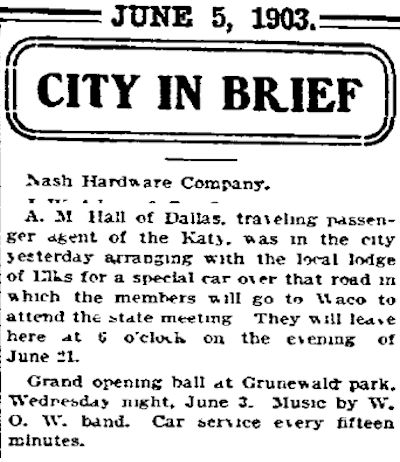 By the early twentieth century Fort Worth’s first trolley park, Rosedale Pavilion, was called “Grunewald Park.” Owner Peter Grunewald did not advertise much in local newspapers, but his grand opening ball of the 1903 season did get into the Fort Worth Telegram’s daily column “City in Brief,” which contained as many ads as news items. The running ad for Nash Hardware Company did not get even a complete sentence. Charles E. Nash probably paid to have his company’s name appear at the top of the column each day.
By the early twentieth century Fort Worth’s first trolley park, Rosedale Pavilion, was called “Grunewald Park.” Owner Peter Grunewald did not advertise much in local newspapers, but his grand opening ball of the 1903 season did get into the Fort Worth Telegram’s daily column “City in Brief,” which contained as many ads as news items. The running ad for Nash Hardware Company did not get even a complete sentence. Charles E. Nash probably paid to have his company’s name appear at the top of the column each day.
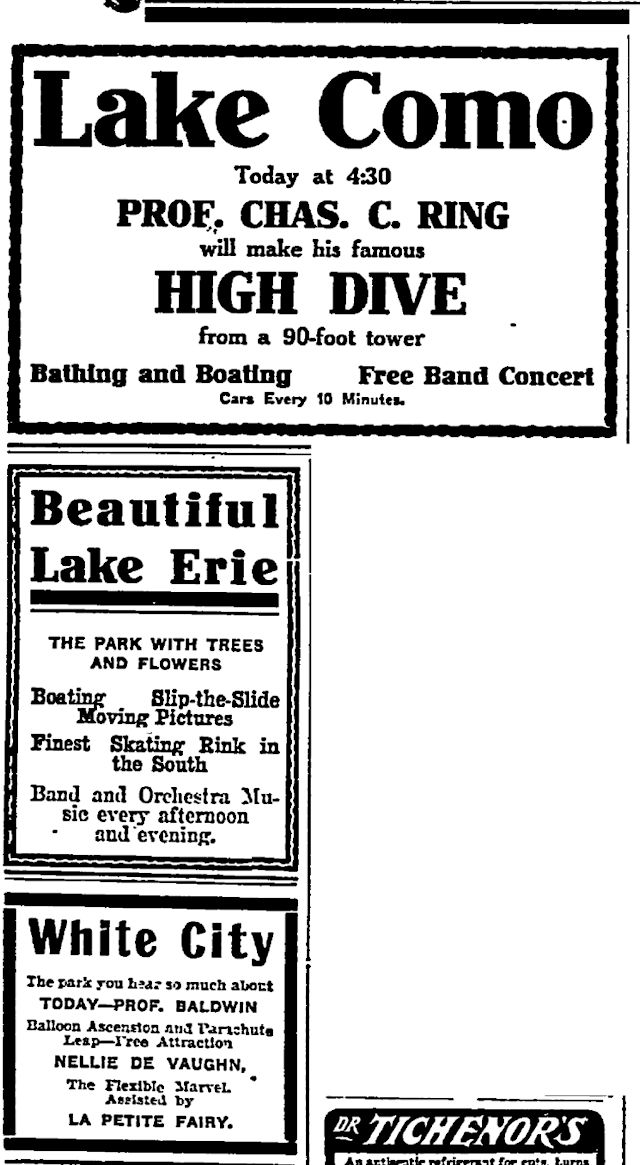 By 1906 ads for the other three trolley parks—Lake Como, Lake Erie, and White City—could be read on the same page of the Telegram, such as on August 5. (Nellie de Vaughn, the “Queen of the Clouds,” would commit suicide on August 7.)
By 1906 ads for the other three trolley parks—Lake Como, Lake Erie, and White City—could be read on the same page of the Telegram, such as on August 5. (Nellie de Vaughn, the “Queen of the Clouds,” would commit suicide on August 7.)
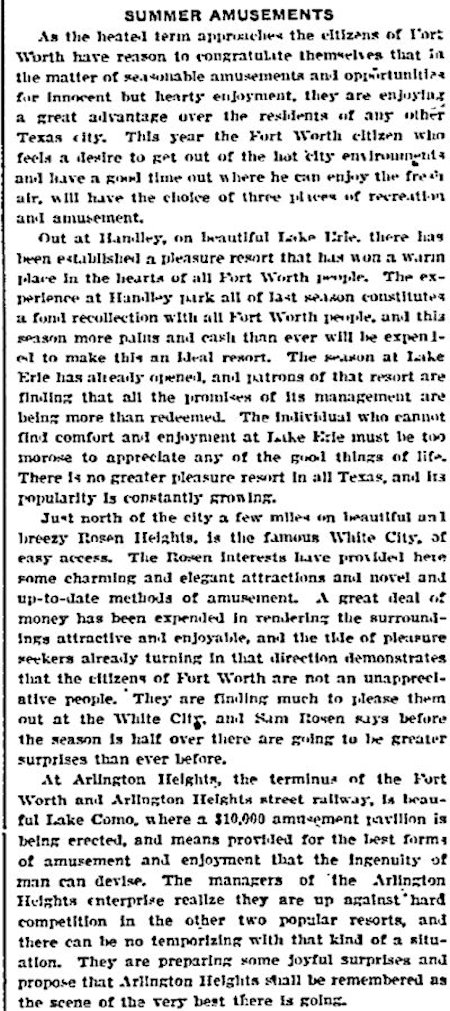 At the start of the “heated term” each year the Telegram also published a preview of the three parks. Clip is from May 6, 1906.
At the start of the “heated term” each year the Telegram also published a preview of the three parks. Clip is from May 6, 1906.
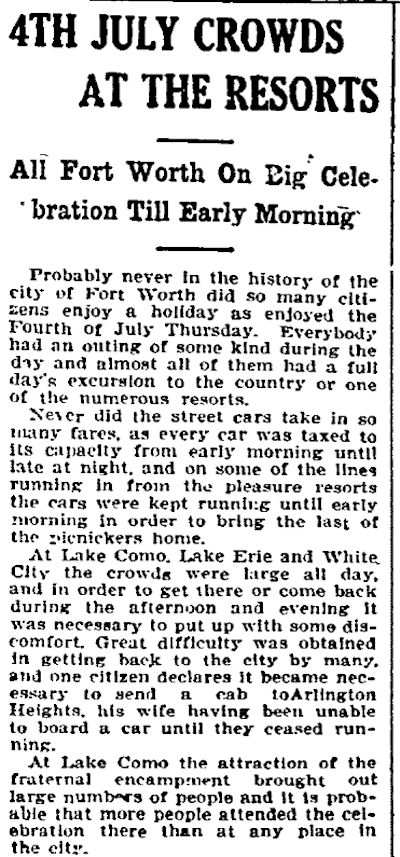 And each July 5 the Telegram printed a roundup of the Independence Day fun at the trolley parks. Clip is from 1907.
And each July 5 the Telegram printed a roundup of the Independence Day fun at the trolley parks. Clip is from 1907.
Lake Erie was pleasure born of pragmatism. On June 18, 1902 Northern Texas Traction Company began its interurban service between Fort Worth and Dallas. To provide electricity for its cars, NTTC had built a generating plant in Handley. To provide water for the plant, the company impounded a creek to form a small lake: Lake Erie. In 1903, to give that lake double duty, the company built a pavilion, skating rink, auditorium, and other attractions and opened Lake Erie as a trolley park on the Dallas interurban line.

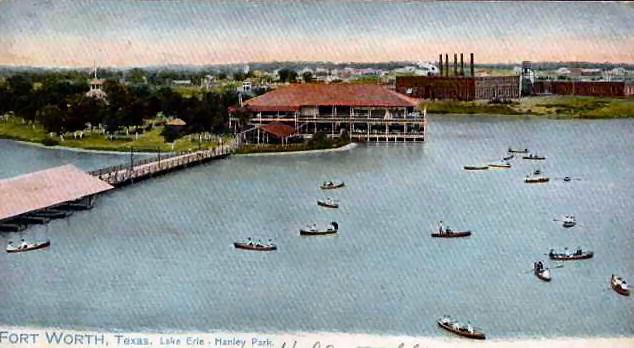 Lake Erie was a popular setting for barbecues, picnics, and boat excursions. The NTTC power plant can be seen in the background.
Lake Erie was a popular setting for barbecues, picnics, and boat excursions. The NTTC power plant can be seen in the background.

This postcard shows the powerhouse with the lake and pavilion in the background.
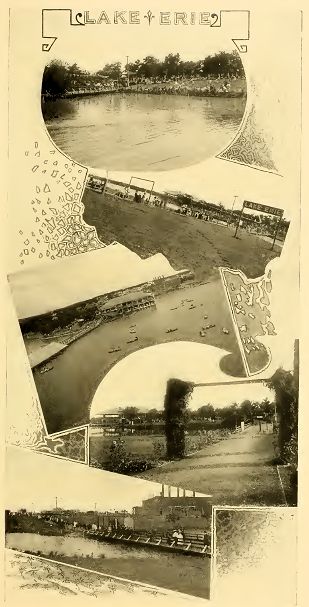 Views of Lake Erie in Greater Fort Worth (1907).
Views of Lake Erie in Greater Fort Worth (1907).
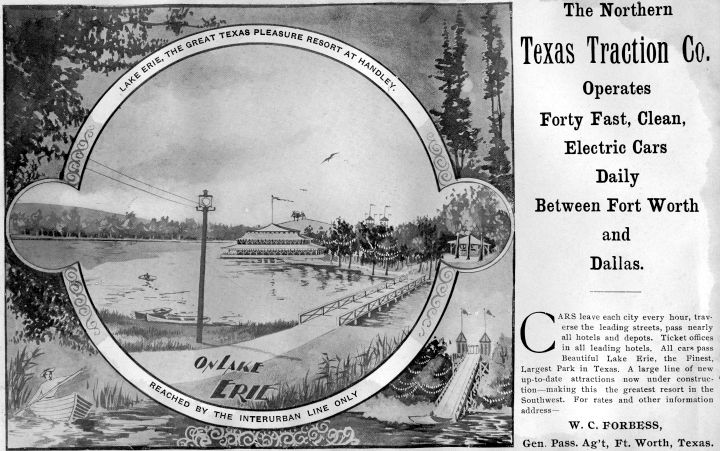 An ad in the 1906 Panther City Parrot yearbook of Polytechnic College.
An ad in the 1906 Panther City Parrot yearbook of Polytechnic College.
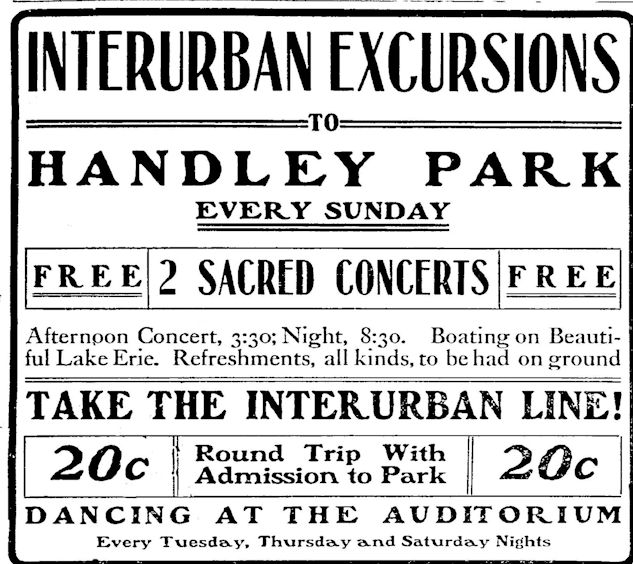 Lake Erie offered interurban patrons moving pictures, fireworks, slip-the-slide, shoot-the-chutes, and a band for dancing on Tuesday, Thursday, and Saturday nights. Ad is from the June 12, 1903 Telegram.
Lake Erie offered interurban patrons moving pictures, fireworks, slip-the-slide, shoot-the-chutes, and a band for dancing on Tuesday, Thursday, and Saturday nights. Ad is from the June 12, 1903 Telegram.
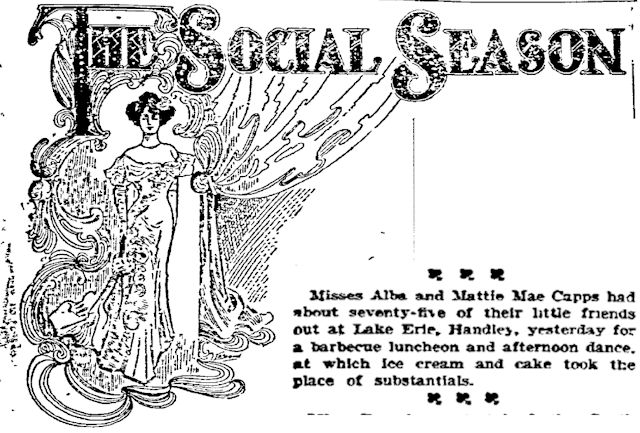 On May 10, 1903 the Gazette society column reported that the daughters of prominent attorney William Capps and “seventy-five of their little friends” enjoyed a barbecue and dance at the lake.
On May 10, 1903 the Gazette society column reported that the daughters of prominent attorney William Capps and “seventy-five of their little friends” enjoyed a barbecue and dance at the lake.
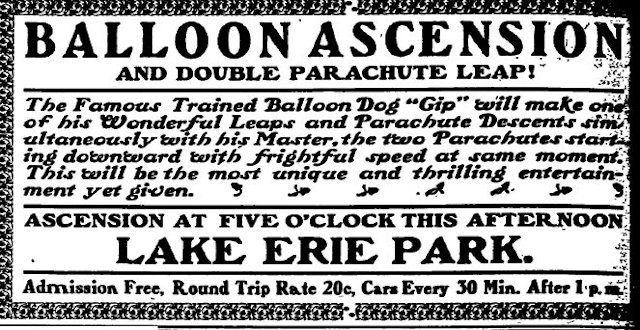 Balloon ascensions were popular spectacles early in the twentieth century. On August 16, 1903 the Telegram announced that Lake Erie would present the “famous trained balloon dog ‘Gip.’” Gip would make “one of his wonderful leaps and parachute descents simultaneously with his Master, the two parachutes starting downward with frightful speed at the same moment.”
Balloon ascensions were popular spectacles early in the twentieth century. On August 16, 1903 the Telegram announced that Lake Erie would present the “famous trained balloon dog ‘Gip.’” Gip would make “one of his wonderful leaps and parachute descents simultaneously with his Master, the two parachutes starting downward with frightful speed at the same moment.”
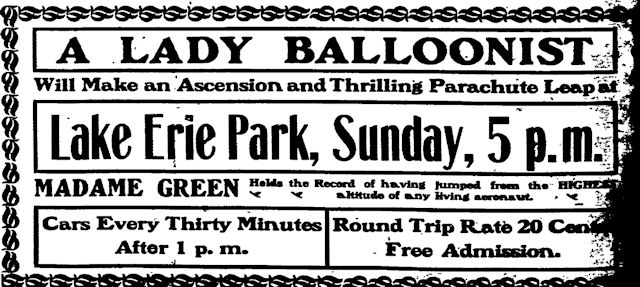 On August 28, 1903 the Telegram announced that “lady balloonist” Madame Green, who “holds the record for having jumped from the highest altitude of any living aeronaut,” would make “an ascension and thrilling parachute leap” at Lake Erie. Admission was free with a twenty-cent round-trip interurban ticket. “Cars every thirty minutes.”
On August 28, 1903 the Telegram announced that “lady balloonist” Madame Green, who “holds the record for having jumped from the highest altitude of any living aeronaut,” would make “an ascension and thrilling parachute leap” at Lake Erie. Admission was free with a twenty-cent round-trip interurban ticket. “Cars every thirty minutes.”
 On June 5, 1906 the Telegram reported that Lake Erie was showing “moving pictures” of the San Francisco earthquake of April 18. Such an early “newsreel” must have been fascinating to viewers. That earthquake footage probably was similar to footage at the Library of Congress.
On June 5, 1906 the Telegram reported that Lake Erie was showing “moving pictures” of the San Francisco earthquake of April 18. Such an early “newsreel” must have been fascinating to viewers. That earthquake footage probably was similar to footage at the Library of Congress.
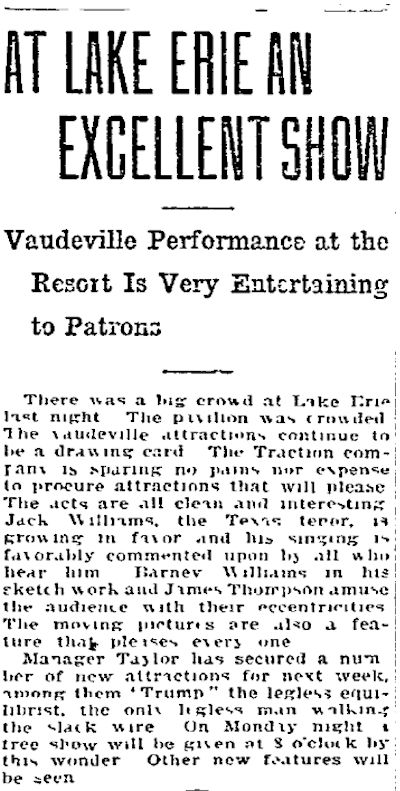 On July 15, 1904 the Telegram declared a vaudeville performance and moving pictures at Lake Erie to be “very entertaining” and reported that the resort soon would feature Trump, the “legless equilibrist.” George Trump had lost his legs in a train accident as a youth and not only learned to walk on his hands but also became a high-wire hand balancer and acrobat in vaudeville.
On July 15, 1904 the Telegram declared a vaudeville performance and moving pictures at Lake Erie to be “very entertaining” and reported that the resort soon would feature Trump, the “legless equilibrist.” George Trump had lost his legs in a train accident as a youth and not only learned to walk on his hands but also became a high-wire hand balancer and acrobat in vaudeville.
Despite the lure of such attractions as Trump the legless equilibrist, the Lake Erie resort, like the other trolley parks, closed as the interurban, like the streetcars, faced increasing competition from automobiles and buses. The park at Lake Erie operated into the early 1920s. The interurban made its last run in 1934. Lake Erie (the body of water) survived as NTTC’s generating plant became Texas Electric Service Company’s generating plant, and in 1957 little Lake Erie became the northwestern inlet of the new Lake Arlington.
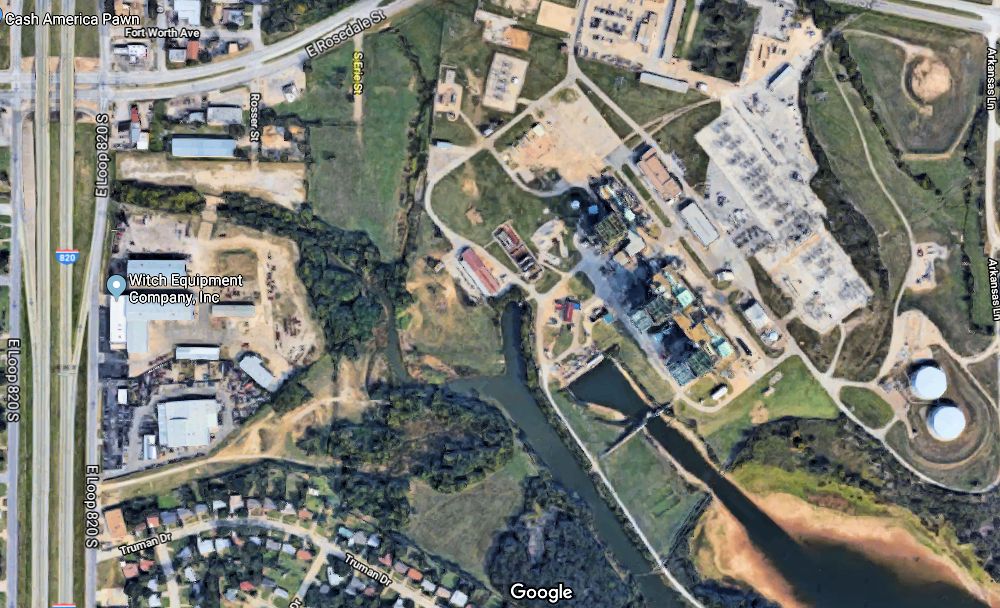 Erie Street survives just north of that inlet.
Erie Street survives just north of that inlet.
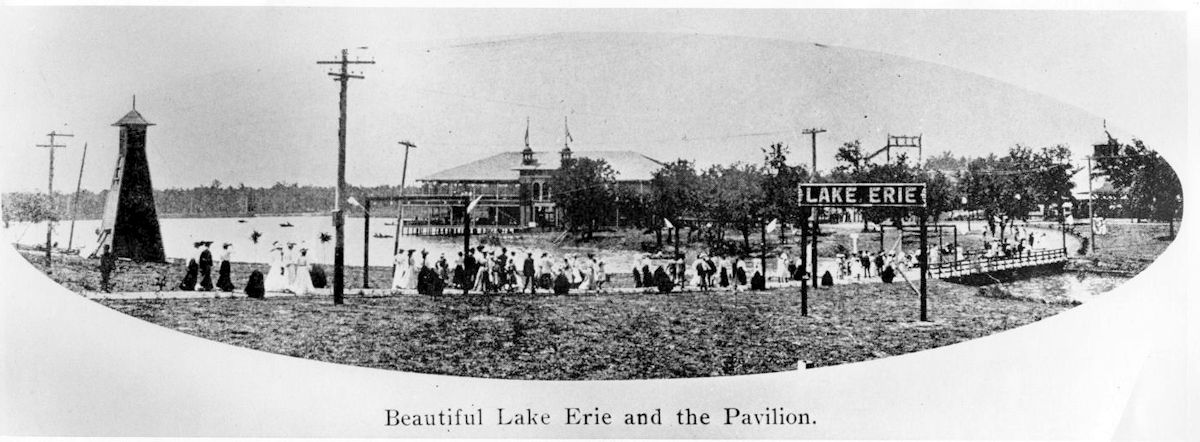 Photo from Arlington Historical Society’s Fielder House Museum.
Photo from Arlington Historical Society’s Fielder House Museum.
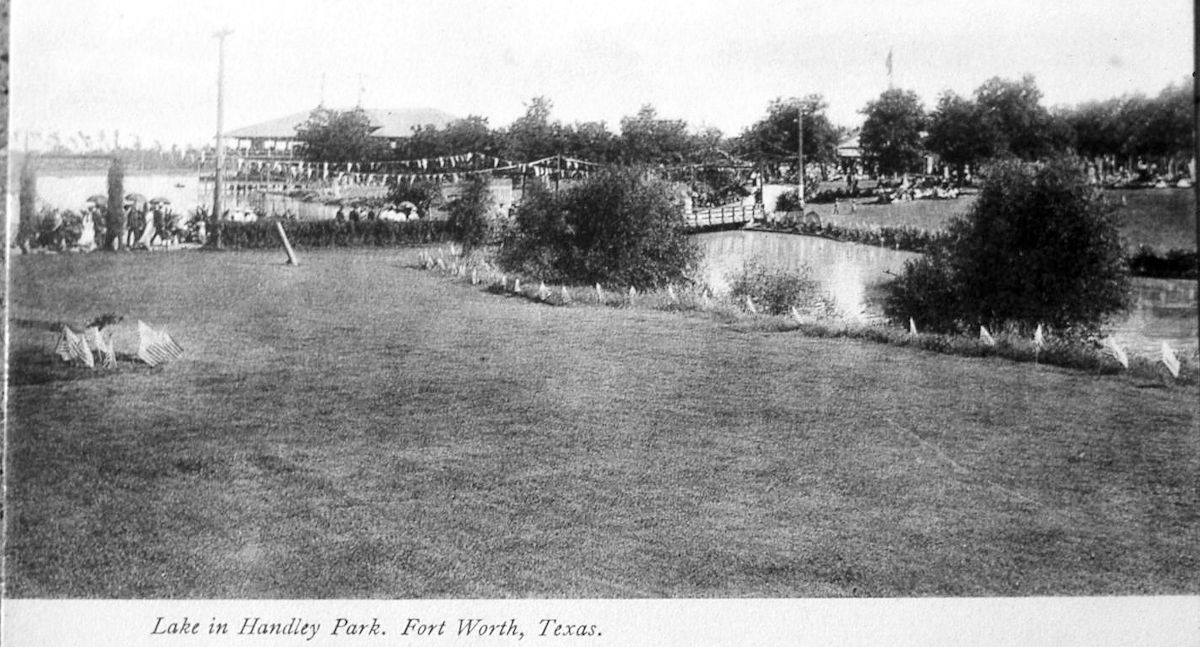 Photo from Arlington Historical Society’s Fielder House Museum.
Photo from Arlington Historical Society’s Fielder House Museum.
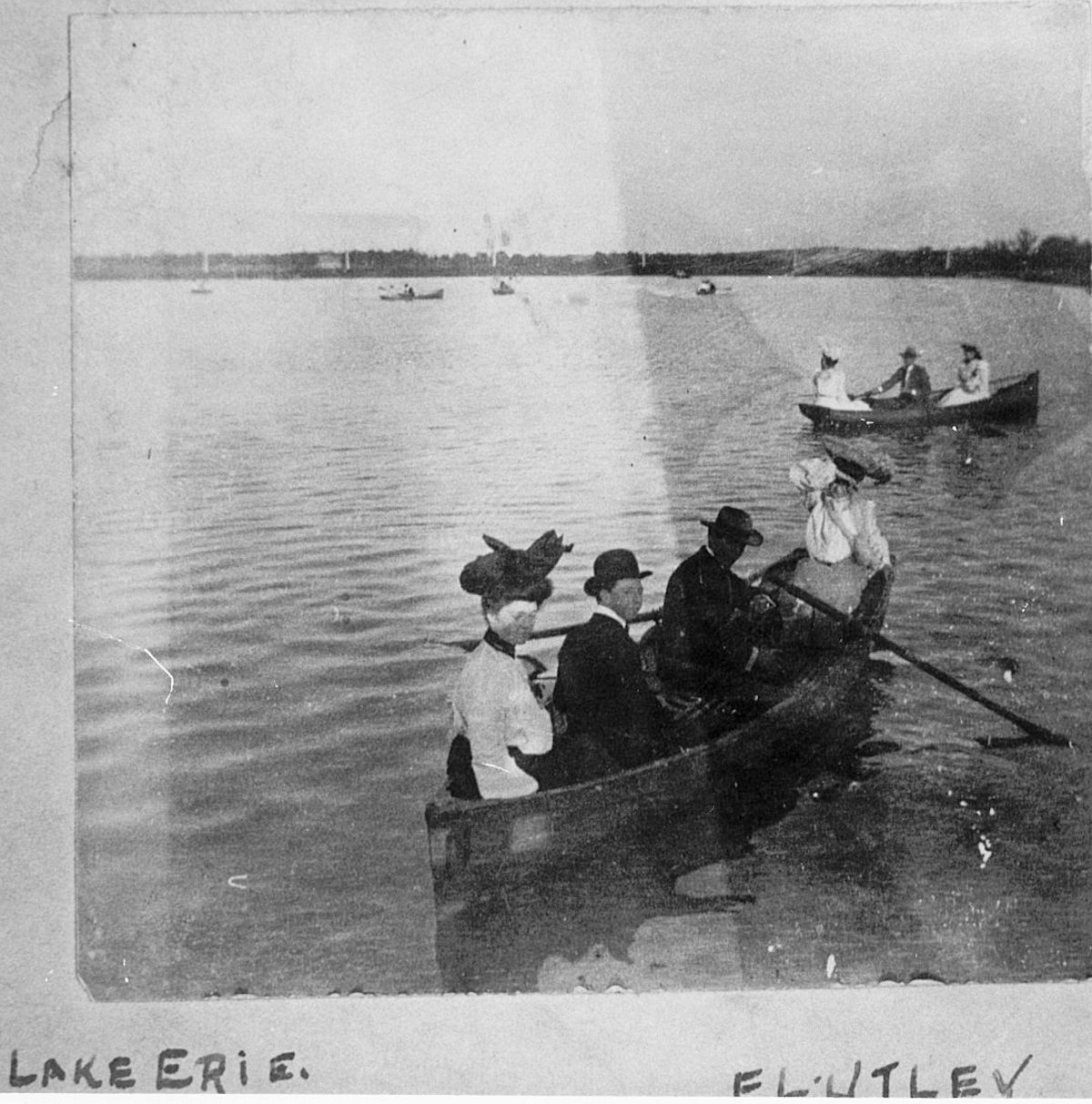 Photo from Tarrant County College Northeast, Heritage Room.
Photo from Tarrant County College Northeast, Heritage Room.






It just occurred to me that the Lake Arlington pool level is lower than Lake Erie’s. This means that the Lake Erie dam must have been demolished when Lake Arlington was built. It raises curiosity in my mind how they coordinated that with Texas Electric. The 1957 photo at historicaerials.com shows only a residual puddle in Erie’s old lake bed, so the plant must have gone without cooling water for a few weeks at least?
Good question, Chris. I found very little in the S-T about impounding Lake Arlington. And when you search the archive for “Lake Erie,” all you get is the big one up north.
How wonderful that these pictures were preserved. I would never have known that there was a Lake Erie in Handley, if I hadn’t seen the pictures. Thank goodness for the Star Telegram in those days, also
How very interesting. I stumbled across the picture of the canoes on Lake Erie yesterday while looking for some family history and then looked for more information about the lake. I can identify the photographer as Frank Lawrence Utley, my great-grandfather. He was born in Fort Worth in 1884. I have a copy of a contract FL Utley had for providing movie equipment at Lake Como in 1906. Your narrative helps greatly to develop this piece of our family history.
Thank you, Gay Barnett. The 1905 city directory shows Frank L. at 800 Missouri Avenue with four other male Utleys.
Thank you very much, but this information is about 80 years before the place that I am looking for. It was still in operation in the 1990’s.
Also contributing to their demise was the construction of Lake Worth in 1914 and the subsequent rise of Casino Beach.
Thanks, Chris. I mention the competition from the new Lake Worth in the posts on the two parks on the west side: Como and White City. The resort at Lake Erie was probably the last of the four to close in the early 1920s.
Here’s a view inside one of NTT city cars:
http://digital.hagley.org/PC20110426_454?solr_nav%5Bid%5D=0968436751276f99c0e3&solr_nav%5Bpage%5D=1&solr_nav%5Boffset%5D=20
Great photo. Thanks for the tip.